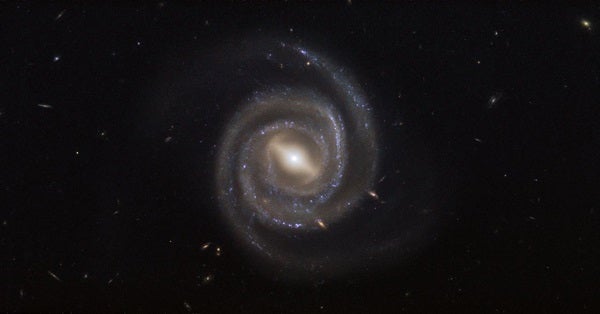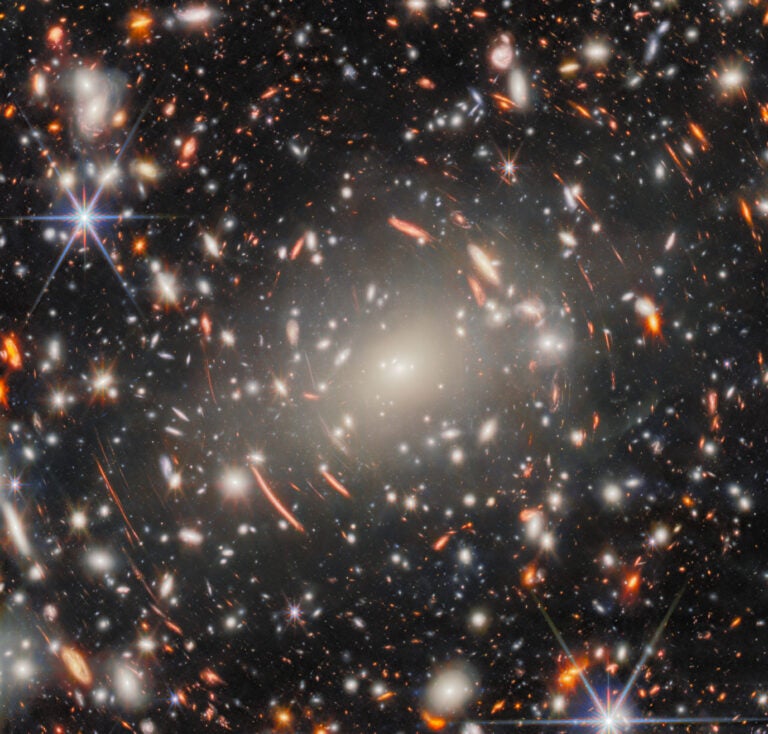Now, new research published August 23 in the Monthly Notices of the Royal Astronomical Society is bolstering a simple idea about how these pairs evolve. The authors found that galaxies and their black holes grow together, regardless of where in the universe they are.
“The observed relation between the mass of the central supermassive black hole the stellar mass of a galaxy has long been a puzzle,” Thomas Quinn of the University of Washington, a co-author on the new study published, told Astronomy in an email. And the puzzle’s solution has significant implications for how galaxies form and evolve in our universe.
A cosmic link
Astronomers already know there’s a close relationship between the size of a galaxy and the size of its supermassive black hole. That indicates the two somehow know about each other, despite the fact that the supermassive black hole is so much smaller than the galaxy around it.
You may imagine a giant black hole sucking in everything around it until the entire galaxy disappears like water down a drain, but that’s simply impossible. Gravity’s influence diminishes quickly as the distance between two objects increases. So, stars more than a few light-years away from the galaxy’s center aren’t ruled by the supermassive black hole’s presence at all, but instead by the mass of stars, gas, and dust around them.
A typical supermassive black hole only accretes, or sucks in, matter from a region just a few light-years across. And its gravity only influences the central few parsecs — about 10 light-years or so, 1 parsec is 3.26 light-years — of the galaxy.
And yet, the mass of a galaxy’s spheroid component — its central bulge — and the mass of its supermassive black hole are related. There’s also a link between the way stars in a galaxy’s bulge move and the mass of its supermassive black hole. What these relationships mean is that somehow, the galaxy at large and its supermassive black hole are connected. So, of course, astronomers want to know how.
Simulating the universe
Galaxy evolution happens over billions of years. Astronomers piece the process together by looking at many different galaxies in many different stages of evolution. But they can’t reconstruct every moment in the complete life of a galaxy and its black hole.
But computer simulations can show galaxies and their black holes from start to finish, giving insight into what’s happening. In fact, they can show thousands of galaxies, all growing and evolving over time.
Quinn and his colleagues used sophisticated code, called ROMULUS, to watch young galaxies evolve, looking at how much the supermassive black hole’s activity influenced the amount of star formation in the galaxy, and how the galaxy’s growth affected the black hole’s feeding habits. Their simulation included thousands of galaxies in various environments, from galaxy clusters to regions where galaxies are few and far between, exactly like the real universe.
Their work gives the clearest picture to date of how black holes and galaxies grow together, and shows that the two appear closely coupled, regardless of many of the factors that might disrupt their symbiosis. “What this study shows is that the supermassive black hole and the stellar population of a galaxy grow together,” Quinn said. The team found that no matter how many stars a galaxy was forming, only a small fraction of the gas available to make new stars was gobbled up by the central black hole instead.
And the fraction of gas consumed by the black hole, he said, stayed the same even in the face of factors the team thought might change it. The black hole had the same amount of food regardless of the number of nearby galaxies, how long the galaxy had to evolve, and even the number of other galaxies it had smashed into in the past. That’s interesting because galaxy interactions like flybys that happen in clusters — such as the nearby Virgo Cluster — and mergers such as the famous Antennae Galaxies can affect both star formation and black hole activity in galaxies.
The team also found that because that fraction of gas available to the black hole stays the same, galaxies and supermassive black holes have a relationship that is “self-correcting.” If the supermassive black hole starts out too large for its galaxy, a lack of available gas and dust in the galaxy appears to throttle down the black hole’s progress so it grows more slowly. Alternatively, if the black hole is small relative to its galaxy, plentiful gas and dust allows the black hole to grow at a faster rate, ultimately catching up to its host.
Of course, the results offer a generalized picture and some galaxies may not follow this template, especially as their central black holes go through periods of high activity, which most do. Quinn suggests that perhaps observing real galaxies at the extremes of the model, such as galaxies with very active black holes or dwarf galaxies with extremely heavy black holes, could help to confirm whether this model is a good fit for all, or if tweaks are needed under certain circumstances.











